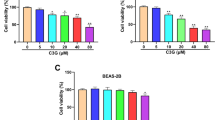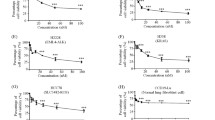Abstract
Scientists are finding the most effective chemotherapeutic agents for the treatment of cancer. In the present study, we evaluated the anticancer mechanism of DPPG, a derivative of DAPG (2,4-diacetylphloroglucinol), for the first time. DPPG and DAPG inhibited 83 and 59% of human colorectal cancer HCT116 cell growth at 40.0 µg/ml, and 74 and 57% of human lung cancer A549 cell growth at 10.0 µg/ml concentrations respectively. Furthermore, DPPG and DAPG inhibited 97 and 73% colony formation of the HCT116 cells at 20.0 µg/ml concentration. DPPG and DAPG induced apoptosis in the HCT116 and A549 cells that was confirmed by Hoechst 33342 and FITC-annexin V staining. This result also revealed that ROS generated in both the HCT116 and A549 cells after treatment with DPPG. However, no ROS production was observed in HCT116 and A549 cells after treatment with DAPG. Both DAPG and DPPG significantly increased the CASP3 protein expression that was detected by staining the cells with the super-view 488-CASP3 substrate. Expression of WNT1 gene was eliminated in DPPG and DAPG treated HCT116. Expression of MAPK1 gene was entirely abolished in DPPG treated cells, whereas a significant decrease was observed for DAPG. An intense band of CASP8 gene product was observed agarose gel for DPPG treated HCT116 cells than DAPG. Molecular docking simulation showed the high binding affinities (≥ 6.5 kcal/mol) of DPPG and DAPG with target proteins WNT1, MAPK1, CASP8, and CASP3 in HCT116 cells. This manuscript demonstrated that DAPG and DPPG inhibited lung and colorectal cancer cells by inducing apoptosis.
Graphical abstract
DAPG and DPPG inhibited A549 and HCT116 cells growth by inducing apoptosis








Similar content being viewed by others
Data availability
Data sharing not applicable to this article as no data sets were generated or analyzed during the current study.
References
Qureshi KA, Bholay AD, Rai PK, Mohammed HA. Isolation, characterization, anti-MRSA evaluation, and in-silico multi-target anti-microbial validations of actinomycin X2 and actinomycin D produced by novel Streptomyces smyrnaeus UKAQ_23. Sci Rep. 2021;11:1–21.
Bender CL, Loper JE. Polyketide production by plantassociated Pseudomonads. Annu Rev Phytopathol. 1999;37:175–96.
Bangera MG, Thomashow LS. Identification and Characterization of a Gene Cluster for Synthesis of the Polyketide Antibiotic 2,4-Diacetylphloroglucinol from Pseudomonas fluorescens Q2–87. J Bacteriol. 1999;181:3155–63.
Isnansetyo A, Cui L, Hiramatsu K, Kamei Y. Antibacterial activity of 2,4-diacetylphloroglucinol produced by Pseudomonas sp. AMSN isolated from a marine alga, against vancomycin-resistant Staphylococcus aureus. Int J Antimicrob Agents. 2003;22:545–7.
Kamei Y, Isnansetyo A. Lysis of methicillin-resistant Staphylococcus aureus by 2,4-diacetylphloroglucinol produced by Pseudomonas sp. AMSN isolated from a marine alga. Int J Antimicrob Agents. 2003;21:71–4.
De Souza JT, Arnould C, Deulvot C, Lemanceau P, Gianinazzi-Pearson V, Raaijmakers JM. Effect of 2,4-diacetylphloroglucinol on Pythium: Cellular responses and variation in sensitivity among propagules and species. Phytopathology. 2003;93:966–75.
Islam MT, Fukushi Y. Growth inhibition and excessive branching in Aphanomyces cochlioides induced by 2,4-diacetylphloroglucinol is linked to disruption of filamentous actin cytoskeleton in the hyphae. World J Microbiol Biotechnol. 2010;26:1163–70.
Gleeson O, O’Gara F, Morrissey JP. The Pseudomonas fluorescens secondary metabolite 2,4 diacetylphloroglucinol impairs mitochondrial function in Saccharomyces cerevisiae. Antonie van Leeuwenhoek, Int J Gen Mol Microbiol. 2010;97:261–73.
Islam MT, von Tiedemann A. 2,4-Diacetylphloroglucinol suppresses zoosporogenesis and impairs motility of Peronosporomycete zoospores. World J Microbiol Biotechnol. 2011;27:2071–9.
Jousset A, Lara E, Wall LG, Valverde C. Secondary metabolites help biocontrol strain Pseudomonas fluorescens CHA0 to escape protozoan grazing. Appl Environ Microbiol. 2006;72:7083–90.
Veena VK, Popavath RN, Kennedy K, Sakthivel N. In vitro antiproliferative, pro-apoptotic, antimetastatic and anti-inflammatory potential of 2,4-diacteylphloroglucinol (DAPG) by Pseudomonas aeruginosa strain FP10. Apoptosis. 2015;20:1281–95.
Kabir SR, Dai Z, Nurujjaman M, Cui X, Asaduzzaman AKM, Sun B, et al. Biogenic silver/silver chloride nanoparticles inhibit human glioblastoma stem cells growth in vitro and Ehrlich ascites carcinoma cell growth in vivo. J Cell Mol Med. 2020;24:13223–34.
Kabir SR, Asaduzzaman A, Amin R, Haque AT, Ghose R, Rahman MM, et al. Zizyphus mauritiana fruit extract-mediated synthesized silver/silver chloride nanoparticles retain antimicrobial activity and induce apoptosis in MCF—7 cells through the Fas pathway. ACS Omega. 2020;5:20599–608.
Kabir SR, Islam J, Ahamed MS, Alam MT. Asparagus racemosus and Geodorum densiflorum lectins induce apoptosis in cancer cells by altering proteins and genes expression. Int J Biol Macromol. 2021;191:646–56.
Kabir SR, Islam F, Asaduzzaman AKM. Biogenic silver/silver chloride nanoparticles inhibit human cancer cells proliferation in vitro and Ehrlich ascites carcinoma cells growth in vivo. Sci Rep. 2022;12:1–14.
Berman HM, Battistuz T, Bhat TN, Bluhm WF, Bourne PE, Burkhardt K, et al. The protein data bank. Acta Acta Crystallogr D Biol Crystallogr. 2002;58:899–907.
Kim S, Chen J, Cheng T, Gindulyte A, Jia He SH, Li Q, et al. PubChem 2019 update: improved access to chemical data. Nucleic Acids Res. 2019;47:D1102–9.
Visualizer DS. v4. 0.100. 13345. Accelrys Software Inc. 2005.
Pettersen EF, Goddard TD, Huang CC, Couch GS, Greenblatt DM, Meng EC, et al. UCSF chimera-a visualization system for exploratory research and analysis. J Comput Chem. 2004;25:1605–12.
Dallakyan S, Olson AJ. Small molecule library screening by docking with PyRx. Artic Methods Mol Biol. 2015;1263:243–50.
Salentin S, Schreiber S, Haupt VJ, Adasme MF, Schroeder M. PLIP: fully automated protein–ligand interaction profiler. Nucleic Acids Res. 2015;43:W443–7.
WL D. PyMOL. DeLano Scientific, San Carlos. ci.nii.ac.jp. 2002;700.
Humphrey W, Dalke A, Schulten K. VMD: visual molecular dynamics. J Mol Graph. 1996;14:33–8.
Calvert PM, Frucht H. The genetics of colorectal cancer. Ann Intern Med. 2002;137:603–12.
Mohammed HA, Almahmoud SA, Khan FA, Emwas A, Jaremko M, Almulhim F, et al. Comparative anticancer potentials of taxifolin and quercetin methylated derivatives against HCT-116 cell lines: Effects of O—methylation on taxifolin and quercetin as preliminary natural leads. ACS Omega. 2022;7:46629–39.
Kabir SR, Islam T. Antimycin A induced apoptosis in HCT—116 colorectal cancer cells through the up-and downregulation of multiple signaling pathways. Med Oncol. 2023;40:1–5.
Fathi N, Rashidi G, Khodadadi A, Shahi S, Sharifi S. STAT3 and apoptosis challenges in cancer. Int J Biol Macromol. 2018;117:993–1001.
Kabir KMA, Amin R, Hasan I, Asaduzzaman A, Ahsanul Kabir K, Khatun H, et al. Geodorum densiflorum rhizome lectin inhibits Ehrlich ascites carcinoma cell growth by inducing apoptosis through the regulation of BAX, p53 and NF-κB genes expression. Int J Biol Macromol. 2019;125:92–8.
Islam F, Gopalan V, Lam AKY, Kabir SR. Pea lectin inhibits cell growth by inducing apoptosis in SW480 and SW48 cell lines. Int J Biol Macromol. 2018;117:1050–7.
Islam F, Gopalan V, Lam AKY, Rashel S. International Journal of Biological Macromolecules Kaempferia rotunda tuberous rhizome lectin induces apoptosis and growth inhibition of colon cancer cells in vitro. Int J Biol Macromol. 2019;141:775–82.
Flores-Hernández E, Velázquez DM, Castañeda-Patlán MC, Fuentes-García G, Fonseca-Camarillo G, Yamamoto-Furusho JK, et al. Canonical and non-canonical Wnt signaling are simultaneously activated by Wnts in colon cancer cells. Cell Signal. 2020;72:109636.
He B, Reguart N, You L, Mazieres J, Xu Z, Lee AY, et al. Blockade of Wnt-1 signaling induces apoptosis in human colorectal cancer cells containing downstream mutations. Oncogene. 2005;24:3054–8.
Fang JY, Richardson BC. The MAPK signalling pathways and colorectal cancer Lancet. Lancet Oncol. 2005;6:322–7.
Funding
The authors have not disclosed any funding.
Author information
Authors and Affiliations
Contributions
TI is responsible for DAPG and DPPG isolation. MNHM is responsible for bioinformatics related works. SRK did all of the anticancer-related works, manuscript written, edited and funded to the cancer-related research works.
Corresponding author
Ethics declarations
Conflict of interest
The authors declare no conflict of interest.
Additional information
Publisher's Note
Springer Nature remains neutral with regard to jurisdictional claims in published maps and institutional affiliations.
Rights and permissions
Springer Nature or its licensor (e.g. a society or other partner) holds exclusive rights to this article under a publishing agreement with the author(s) or other rightsholder(s); author self-archiving of the accepted manuscript version of this article is solely governed by the terms of such publishing agreement and applicable law.
About this article
Cite this article
Kabir, S.R., Islam, T. & Mollah, M.N.H. 2,4-Dipropylphloroglucinol inhibits the growth of human lung and colorectal cancer cells through induction of apoptosis. Med Oncol 40, 129 (2023). https://doi.org/10.1007/s12032-023-01986-y
Received:
Accepted:
Published:
DOI: https://doi.org/10.1007/s12032-023-01986-y




